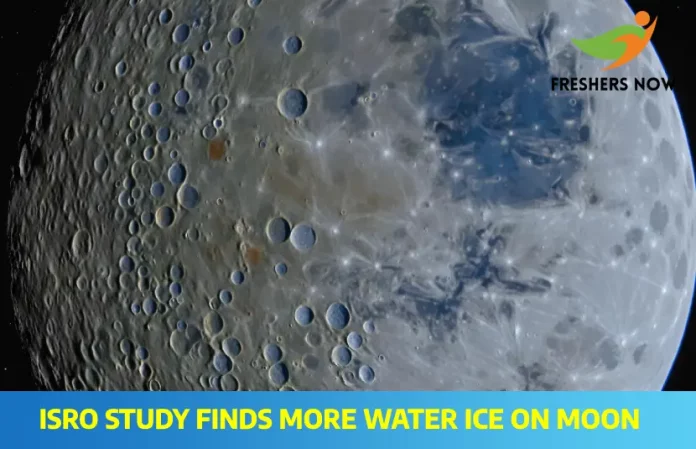
Ice Discovery on Moon | Crucial for Missions, Reveals ISRO Study: A recent collaborative study led by scientists from ISRO’s Space Applications Centre (SAC) has shed light on the Water Ice Discovery on the Moon in the polar craters of the Moon. This discovery holds immense importance for future lunar missions and human exploration endeavors. Enhanced Possibilities of Water Ice on the Moon.
Understanding Water Ice Occurrence
The study reveals that the amount of subsurface Water Ice discovered in the Moon’s polar regions, especially within the first couple of meters, surpasses the ice found on the surface. Let’s delve into the findings and their implications:
- Distribution Disparity:
Researchers found that the extent of water ice in the northern polar region is twice as much as that in the southern polar region. This discrepancy in distribution could influence future exploration strategies. - Origins of Lunar Water Ice:
The primary source of subsurface Water Ice Discovery on the Moon in the lunar poles is believed to be outgassing during the Cambrian period’s volcanism. The distribution of this ice is likely shaped by Mare volcanism and preferential impact cratering.
ISRO Study – Research Tools Utilized
To study the origin and distribution of Water Ice on the Moon, the research team utilized various instruments aboard the Lunar Reconnaissance Orbiter. These include radar, laser, optical, neutron spectrometer, ultra-violet spectrometer, and thermal radiometer.
ISRO Study – Significance for Future Missions
Accurate knowledge of water ice occurrence in the lunar poles is crucial for upcoming missions exploring lunar volatiles. This study supports ISRO’s plans for in-situ volatile exploration on the Moon.
ISRO’s In-Situ Volatile Exploration
ISRO is gearing up for future missions to explore and study water Ice Discovery on the Moon and other volatiles in the permanently shadowed polar regions of the Moon. Here’s what you need to know about ISRO’s In-Situ Volatile Exploration plans:
- Objectives:
One of the primary objectives is to attempt in-situ resource utilization (ISRU) of lunar water ice for generating rocket propellant and other resources. This is crucial for enabling sustainable lunar exploration. - Technological Developments:
ISRO is actively developing landers and rovers with the capability to drill into the lunar surface to extract and analyze sub-surface volatile deposits like water ice. Technologies such as cryogenic sample handling, volatile extraction plants, and ISRU propellant production plants are being developed for utilizing lunar resources effectively. - Chandrayaan-3 Mission:
The Chandrayaan-3 mission, scheduled for launch in 2024, will carry a small lander and rover to study the composition of lunar soil. It will also feature an instrument to detect and study the lunar exosphere. - Long-Term Goals:
In the long run, ISRO aims to establish a Lunar Polar Exploration Mission to scout for an ideal location to harvest water for sustained lunar habitat. Detailed study and utilization of lunar volatiles are critical for ISRO’s plans of setting up lunar bases and human spaceflight missions to the Moon.
Conclusion
The recent study highlighting the enhanced possibilities of water ice occurrence on the Moon underscores the significance of continued exploration efforts. With ambitious plans for ISRO’s In-Situ Volatile Exploration, we are poised to unlock the potential of lunar resources for sustainable space exploration.
| You Can Also Check | |
| Current Affairs | |
To know more about Ice Discovery on the Moon. Stay updated! with the latest current affairs and insightful blog posts by following FreshersNow. Don’t miss out on future content that keeps you informed and engaged!



